On Tuesday, Leadership Albuquerque spent the day hearing from a variety of experts on what it might take to make Albuquerque’s Downtown area the vibrant, thriving heart of our city that we all want it to be.
After touting several economic development projects outside of downtown Albuquerque (like the Amazon facility to develop the Westside; Netflix’ investment in Mesa del Sol, set to be completed within two years; and Project Orion, leasing 125 acres at Sunport with plans to build a four-million-square-foot facility), the City’s Chief Operating Officer Lawrence Rael offered some insights into the City’s current work and future plans to revitalize the downtown area. Starting with public safety, he discussed a $2 million investment in lighting to make people feel safer, as well as an Albuquerque Police Department substation in the works at the corner of 4th Street and Central Avenue. “We’re making downtown a priority – it has to be,” he said.
Rael spent a great deal of time discussing the continued development of the Rail Yards to offer more venue space for farmers’ markets and events, the anticipated uses of the new plaza that was finished just before the COVID-19 pandemic hit, and the potential for office space for the Metropolitan Redevelopment Agency or Film Office. Other buildings on the site are fully equipped with utilities and are in a position to be redeveloped, with all environmental concerns addressed. And meanwhile, consultants are evaluating areas downtown to make recommendations for a stadium to become the permanent home for New Mexico United.
Rael said the biggest obstacle for downtown development in Albuquerque has been the historical lack of corporate offices and headquarters in the state (which have often helped drive downtown growth elsewhere). Consequently, he said, the government needs to be much more involved and more public resources tend to have to be committed to the work.
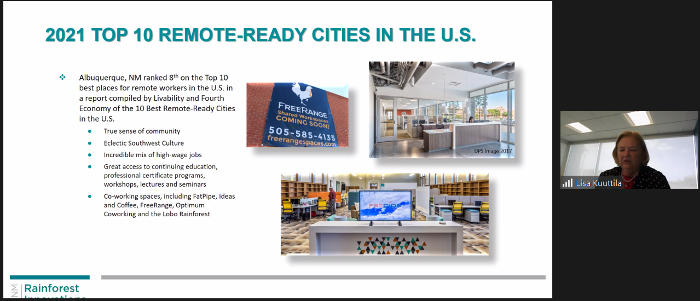
Next, Lisa Kuuttila, President and CEO of UNM Rainforest Innovations, described the incubation and mentoring work in local economic development that her organization – located in the downtown area – spearheads. The team’s work has contributed to a $3.1 billion economic impact statewide.
UNMRI also cultivates networks within the UNM community and across the state, she said. Its partnership with UNM Innovation Academy serves students across UNM in a metacurricular program for all students to foster innovation, creativity, and entrepreneurship. It’s also part of a statewide network to support programs at branch colleges and to partner with research organizations around the state.
As a result, it’s received national recognition and attention. UNMRI has won the Innovation and Economic Prosperity Award, among others, and UNM is ranked second among midsized research universities for innovation impact productivity after Drexel University. Kuuttila also shared some exciting rankings for Albuquerque:
- Albuquerque jumped 72 spots in Milken Institute ranking for best cities, thanks to its performance during pandemic. It’s now in the middle of the pack of 200 large cities at number 89.
- Duke City is 8th in top 10 remote-ready cities and #1 greatest city for creatives, according to Thrillist.
- Albuquerque is 9th for top cities for women in tech, with the fourth lowest gender wage gap.
Kuuttila said the state also has a unique opportunity to attract remote workers, which she said leaders need to capitalize on.
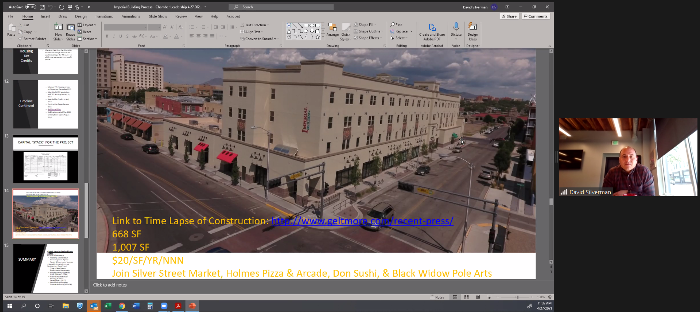
David Silverman of Geltmore offered a unique perspective as a downtown developer and shared the story behind the construction of the Imperial Building.
Starting as an RFP for a grocery store in 2012, Geltmore embarked on a years-long journey of navigating incentives and construction challenges on the site of what was once the Imperial Laundry Company. Many public entities were involved in the project – like the City of Albuquerque’s Metropolitan Redevelopment Agency, the Bernalillo County and New Mexico Economic Development Departments, the Mortgage Finance Authority, the federal Department of Housing and Urban Development, and even then-Congresswoman Michelle Lujan Grisham’s office. The $17.4 million building was finally finished in May 2016 and opened in August that year. Today, the building is home to apartments, restaurants, a dance studio, and a vegetable garden on the roof for residents, plus basement parking, in addition to the grocery store.
Check out the time lapse of the building’s construction here.
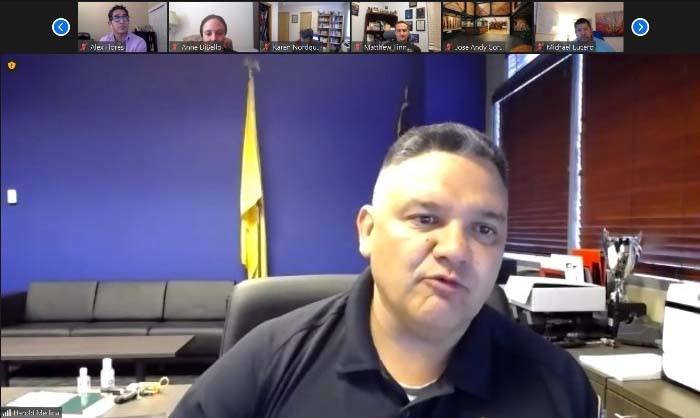
In the afternoon, the group reconvened to hear about downtown policing from Albuquerque Police Department Chief Harold Medina, Commander Josh Brown, and Sergeant Matthew Tinney.
Chief Medina said the priority in downtown policing is to work out root causes of the area’s problems, like a transient population and mental illness. He also said the department is ramping up policing activity in the area as businesses start to reopen after more than a year of limited activity. Medina touted the department’s use of technology, like license plate readers and gunshot detection equipment, as game changers in the fight against crime.
Sergeant Tinney added later that some of his goals are to improve the perception of safety in the area, and to find people likely to be victims – especially people with mental illness or substance abuse challenges – and help protect them.
Commander Brown said APD was taking on the dual challenges of downtown transformation and organizational transformation within APD through the US Department of Justice settlement agreement. He emphasized the importance of a healthy balance of outreach and enforcement, and described a team of 40 “navigators” who help connect people to services.
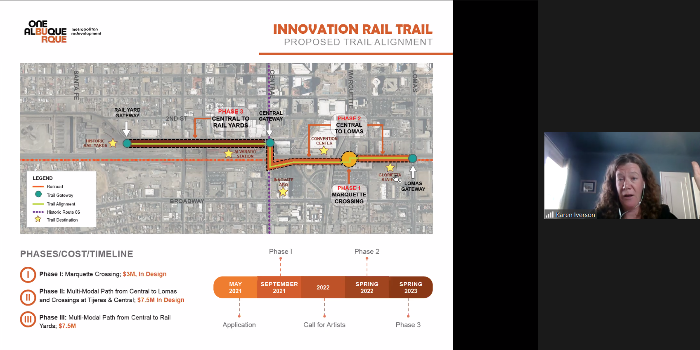
Karen Iverson, Metropolitan Redevelopment Agency Manager, joined the class to discuss some of the more exciting plans for the downtown area: a planned Rail Trail and the future of the Rail Yards.
First, she described her work through the MRA, which covers most of the downtown area, plus “crosshairs” of Central Avenue and 4th Street, as the map below shows. These areas are eligible for a variety of tools, like bonds, fee waivers, and low-interest loans for the remediation of asbestos and lead-based paint. The MRA also invests in projects – $521 million over the last 20 years, with another $1.5 million planned for the year ahead.
The proposed Rail Trail is a multi-modal path for bikes and pedestrians that follows Albuquerque rail lines in an eight-mile loop around the downtown area. As added bonuses, it will also feature sky bridges and/or improved crossings to make it easier for pedestrians to cross Tijeras Avenue and Central Avenue, connect pedestrians to parking, and make undeveloped land in the area more appealing. “This is the kind of amenity that can transform a downtown,” Iverson said.
In discussing the Rail Yards, she first started with a brief history of the giant facility: one of only four steam locomotive repair complexes in America when steam powered the nation – and now the only one remaining. The City acquired the property in 2007. In 2014, the City executed a development agreement with California developer with ambitious design plans, but after years without progress, Mayor Tim Keller canceled the agreement.
Now, exciting new plans are under consideration. Spirit Station, an experiential exhibit in the style of Meow Wolf, is the first tenant on the site. Iverson said a top priority remains reducing risk and dealing with barriers to development.
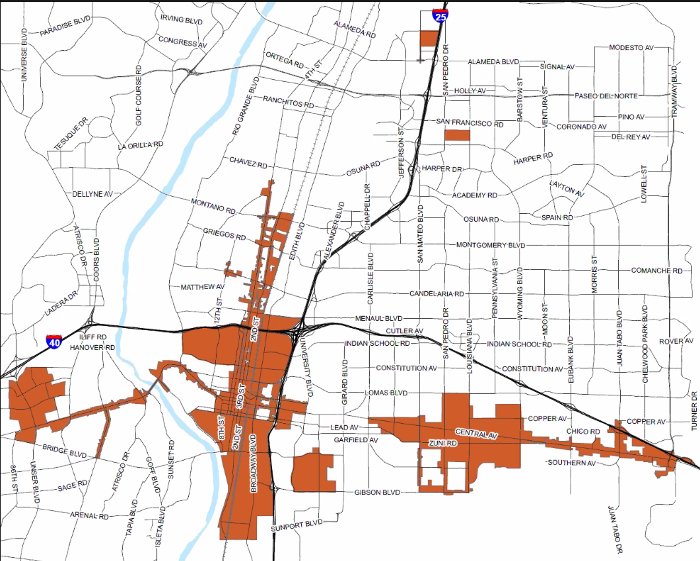
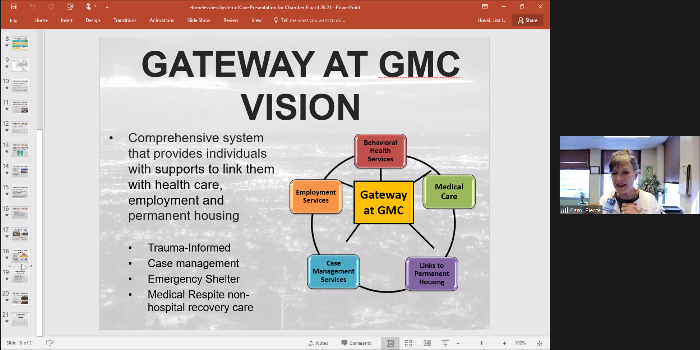
Carol Pierce, Director of the City’s Family and Community Services Department
and Lisa Huval, Deputy Director of Housing and Homelessness in the same department, next updated the Leadership Albuquerque class on Albuquerque’s homeless population.
They said about 1500 people are homeless each night, though families tend to be undercounted. About 39% of those individuals are chronically homeless, defined as experiencing homelessness for 12 straight months or an equivalent amount of time over three years, they added. They described their System of Care as being instrumental in making progress: prevention (like $21M in emergency rental and utility assistance to help pay back-rent) and diversion so fewer people lose their housing, plus outreach to those already in need. Then, they focus on providing emergency shelter and interim housing with the ultimate goal of permanent housing, whatever that may look like for them on an individualized basis. Pierce and Huval also credited their ecosystem of emergency shelters, healthcare facilities, day shelters and meal sites, and behavioral health treatment, case management, and other services as being critical in addressing Albuquerque’s homelessness. Below, you can see a map of the sites across the city, color-coded by the services they offer.
The vision for the future Gateway Center at the Gibson Medical Center is one of a health hub, which the facility has already been for the last 100 years. The 572,000-square-foot facility will offer medical care, behavioral health services, and case management – and links to permanent housing and employment services. Other services could include community health clinics, behavioral health services, sobering services, and self-sufficiency services. Pierce and Huval said community engagement will be critical to the site’s success.
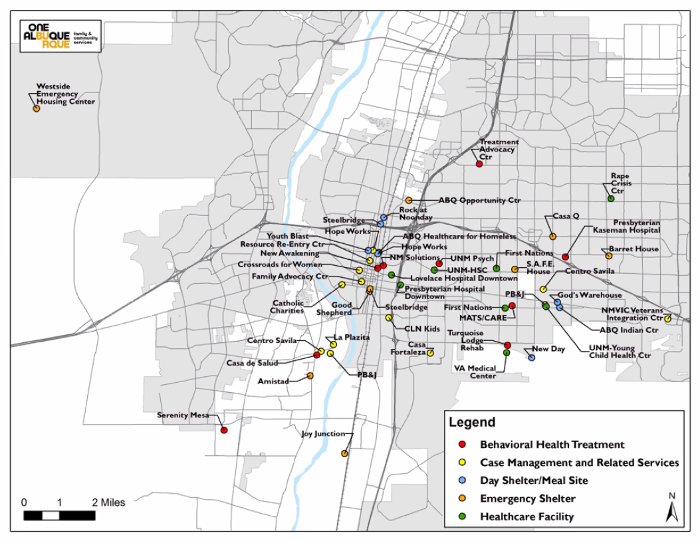
The final presentation of the day came from RS21 CEO Charles Rath, who offered an inspiring look at the rise of the company he founded and later moved to the downtown area. RS21 is a leading data science and visualization firm that continues to expand its staff as it expands the array of clients with whom it works, including the UNM Comprehensive Cancer Center and Bernalillo County District Attorney’s Office. Rath says his company enjoys being downtown, but believes more investment is needed to bring more people to the area. In alignment with the Chamber, he strongly supports the construction of a soccer arena (multi-use sports facility) in downtown Albuquerque. We certainly agree. If the home of the New Mexico United goes anywhere else, it’ll be a major missed opportunity.




